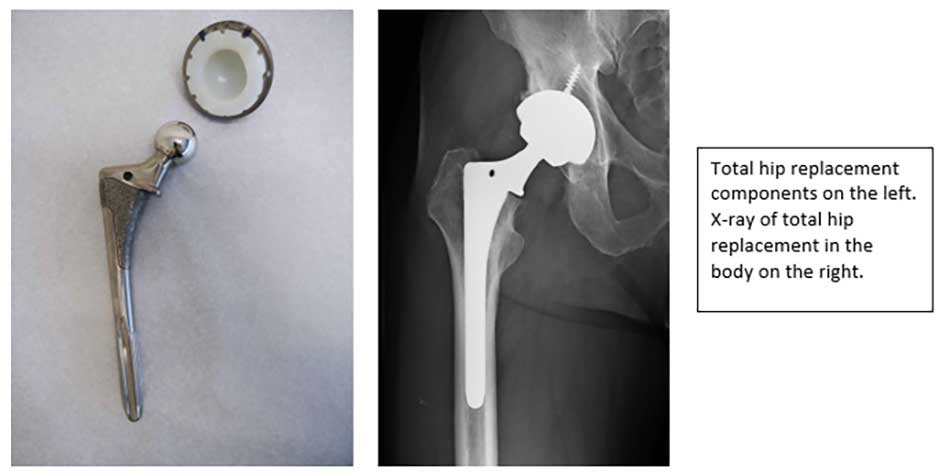Replacement Surgery for Hip Fractures
Introduction
Hip replacement can sometimes be used to treat a broken hip. Normally hip replacement is an elective procedure used to treat arthritis; but in some circumstances, replacing the hip can be an effective option for treating a fracture. Hip fractures are an emergency and almost always require surgery.
Many hip fractures are treated with a “hip pinning” that uses implants such as screws, a large screw and side plate, or a long rod inside the femur (femoral nail). The treatment of choice depends upon the type of fracture, and in some fractures, hip replacement is the best option.

Two types of hip replacement may be used to treat a fracture. A partial replacement (hemiarthroplasty or endoprosthesis) replaces only the ball or head of the thighbone and leaves the socket, known as the acetabulum, untouched. A more modular design called a bipolar prosthesis may be used. A total hip replacement replaces the ball of the femur and the surface of the socket. In general, a total hip replacement is used in younger or more active patients and in people with hip arthritis present before the fracture.

Unlike a bipolar replacement, total hip components are placed separately—the cup separate from the stem. The materials are essentially the same for the implants and they may be inserted with or without cement depending on surgeon preference and the patient’s bone quality.

Indications for Surgery
The three main reasons for using a hip replacement for fracture are:
- Femoral Neck Fracture: A displaced fracture of the ball of the femur where the head of the femur has broken off from the femoral neck.
- Arthritis: A hip fracture in a patient who has arthritis in the hip in addition to the fracture
- Nonunion: A previous fracture of the hip that has failed to heal
1. Femoral Neck Fracture
The head of the femur sits on top of the femoral neck. When the head is broken off and separated from the neck it is not likely to heal (blue arrow below). This is because the blood supply to the ball has often been damaged. For this reason, it is usually better to replace the head of the femur rather than try to put it back in place and pin it with screws.

2. Arthritis
Some patients already have hip joint arthritis at the time they break their hip. They may have had symptoms such as groin pain, stiffness, and limping before the fracture occurs. Other patients may have only mild symptoms but have changes of arthritis on x-ray.
Patients in either of these two groups will benefit from a total hip replacement with replacement of both the ball and socket. This is because a total hip treats the pre-existing arthritis as well as the fracture. A partial replacement or hemiarthroplasty may not treat this condition as well as a full hip replacement.
3. Nonunion (Failure to Heal)
A small number of hip fractures do not heal after they are fixed with a femoral nail, a plate or screws. Hip replacement is often a good choice for these cases. These are usually fractures of the neck of the femur, just below the ball, but can also include inter-trochanteric fractures – a little lower down on the thigh bone.
Hip replacement provides a simpler and easier alternative than options such as bone grafting or a repeat surgery to fix the bone. The recovery is easier, and you can begin to bear full weight on the leg right away when replacement is performed.
Recovery
The recovery from hip replacement for fracture is no different than elective replacement for arthritis. It may, however, take a little longer at the beginning because it is unplanned and done as an emergency. This is different from elective surgery for arthritis. Some hip fracture patients are older and have additional medical problems that may slow recovery.
Most of the time you can get out of bed the next day and put as much weight on your injured leg as you can tolerate. You can advance from a walker or crutches to a cane or no assist at all as you regain strength and balance in your leg. This is different from a hip pinning, where the fracture is repaired, or bone grafting, where you may have to keep weight off your leg until the break heals. This can be six weeks or more.
While recovery from a hip replacement may be shorter and easier, replacement may not be the best choice for everyone. It is often better to preserve the bone of your natural hip for as long as possible. Younger active patients may therefore benefit from having their fracture repaired with screws or plates even though they may take longer to heal. Replacement can then be done later if the hip becomes painful or the fracture does not heal.
If you or a member of your family has a broken hip, your orthopaedic surgeon can discuss surgical options with you and recommend the best treatment.


